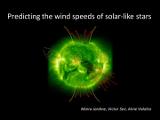Files in this item
Predicting the wind speeds of solar-like stars
Item metadata
| dc.contributor.author | Jardine, Moira | |
| dc.contributor.author | See, V. | |
| dc.contributor.author | Vidotto, A. | |
| dc.date.accessioned | 2017-03-03T10:30:11Z | |
| dc.date.available | 2017-03-03T10:30:11Z | |
| dc.date.issued | 2016-08-01 | |
| dc.identifier | 249288135 | |
| dc.identifier | eba7d087-3846-4355-8c05-7ddf0d951ce8 | |
| dc.identifier.citation | Jardine , M , See , V & Vidotto , A 2016 , ' Predicting the wind speeds of solar-like stars ' , Paper presented at 19th Cambridge Workshop on Cool Stars, Stellar Systems and the Sun (CS19) , Uppsala , Sweden , 6/06/16 - 10/06/16 . https://doi.org/10.5281/zenodo.154589 | en |
| dc.identifier.citation | workshop | en |
| dc.identifier.other | BibCode: 2016csss.confE..15J | |
| dc.identifier.other | ORCID: /0000-0002-1466-5236/work/57821905 | |
| dc.identifier.uri | https://hdl.handle.net/10023/10396 | |
| dc.description.abstract | Some aspects of stellar magnetic activity such as X-ray emission are relatively easy to observe, while others, such as the geometry of the magnetic field are rather more difficult. Indeed, typically only the large-scale (or low-order) components of the field can be mapped. Most elusive of all is the hot, tenuous stellar wind, yet the wind speed is a crucial quantity governing the angular momentum loss of the star. We demonstrate, however, that wind speeds can be predicted reliably even from fairly low-resolution magnetograms. We use an empirically-derived model of the solar wind that predicts the distribution of wind speeds based on surface magnetograms. Using solar magnetic field measurements spanning several magnetic cycles, we demonstrate how changes in the surface magnetic field on various length-scales affect the coronal structure and hence the wind speed. We find that only low-order field components are needed to characterise the wind speed. We compare the variations in wind speed with variations in the X-ray emission over several cycles and show that while the small-scale field has a significant effect on Lx, it has little effect on the wind speed. This suggests that the large number of stellar magnetograms that are becoming available can be used to predict the stellar wind speeds. | |
| dc.format.extent | 14 | |
| dc.format.extent | 6026265 | |
| dc.language.iso | eng | |
| dc.subject | QB Astronomy | en |
| dc.subject | QC Physics | en |
| dc.subject.lcc | QB | en |
| dc.subject.lcc | QC | en |
| dc.title | Predicting the wind speeds of solar-like stars | en |
| dc.type | Conference paper | en |
| dc.contributor.sponsor | Science & Technology Facilities Council | en |
| dc.contributor.institution | University of St Andrews. School of Physics and Astronomy | en |
| dc.identifier.doi | https://doi.org/10.5281/zenodo.154589 | |
| dc.description.status | Peer reviewed | en |
| dc.identifier.url | http://adsabs.harvard.edu/abs/2016csss.confE..15J | en |
| dc.identifier.grantnumber | ST/M001296/1 | en |
This item appears in the following Collection(s)
Items in the St Andrews Research Repository are protected by copyright, with all rights reserved, unless otherwise indicated.

